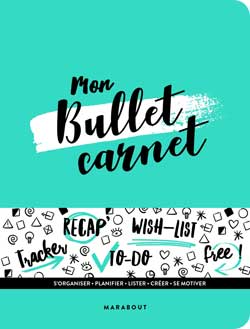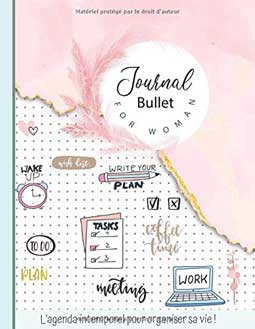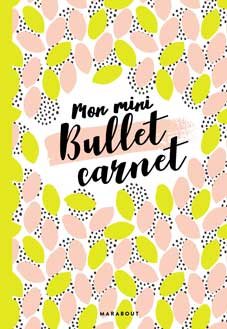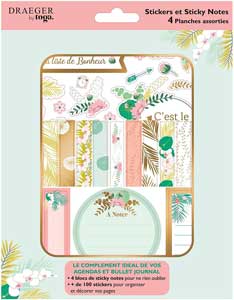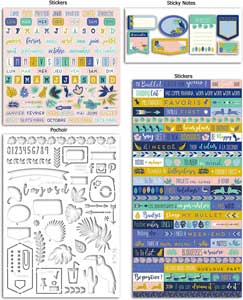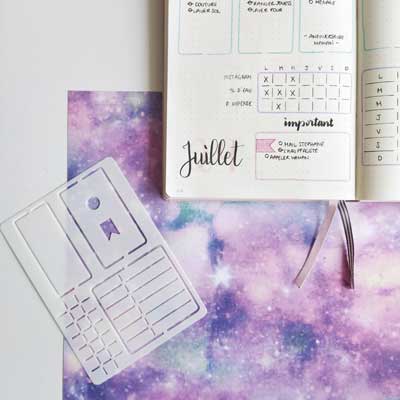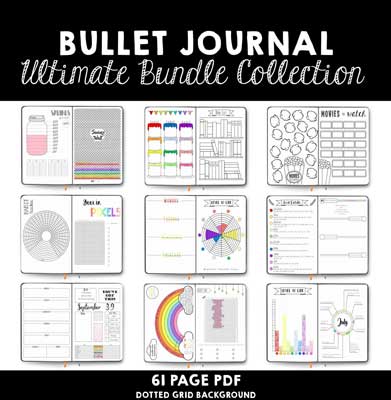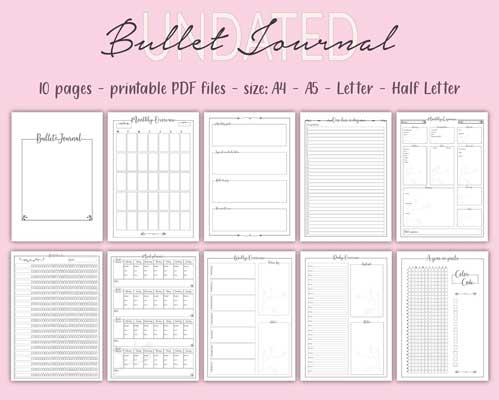If you have even a minimum interest in organization and productivity methods, as well as personal development, you have surely heard of the Bullet Journal or BuJo.
But what is a Bullet Journal? What is it used for? How to create a Bullet Journal and how to use it?
All the answers are here to find out everything about the Bullet Journal.

What is a Bullet Journal? (or BuJo for insiders)
A Bullet Journal is a kind of personalized planner where you can note all your tasks, appointments, past or upcoming events, as well as notes and information that you want to easily find and keep track of.
It’s both a planner, a notepad, a reminder, a diary, a sketchbook, all in one.
It is used for organizing, but also for self-improvement thanks to personal development: indeed, you can develop good habits and follow them, define your goals, achieve your dreams by tracking your projects, etc.
It is called “Bullet” in reference to the “bullet points” that are used to list everything you want to remember and track:
- to-do list,
- shopping list,
- wishlist,
- bucket list: it corresponds to the list of things you would like to do before you die,
- list of habits,
- fitness exercises list,
- recipes list,
- books to read list,
- Netflix series to watch list,
- etc.
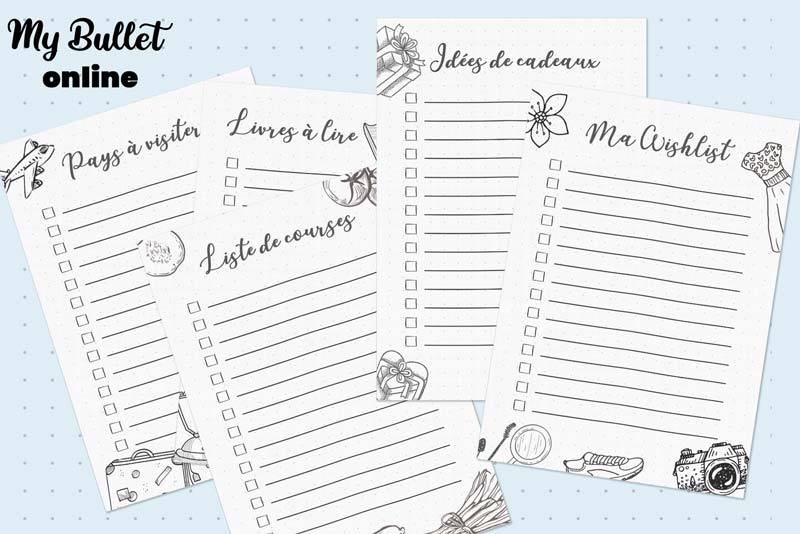
The possibilities are endless because this journal is customizable: both in content and form, the owner of this journal decides the content and creates the page layouts according to his/her own needs and way of organizing.
You can create tables, checkboxes, lines, or other frames to note your content, but also add a more design touch with colors, illustrations, calligraphy.
Often called BuJo, the Bullet Journal has become viral, especially thanks to the “Bullet journalists” (those who Bullet Journal) who share their illustrations on social media.
The act of using your Bullet Journal is called “Bullet Journaling“.
Note that it is mostly women who share on social media, but men also use it, as the creator was a man!
Check out some examples below:
More than just a simple planner, the Bullet Journal is a customized organization method that allows you to be more productive and achieve your goals.

What is the principle of the Bullet Journal?
You have surely already used a classic planner, and you made a choice between one page per day, or 2 days per page, 2 pages per week, etc. You noted your appointments and tasks, and possibly phone numbers (it can always come in handy!). And then you use a notebook for your notes and other scribbles. An additional notebook for your personal journal, another for tracking your exercise routine, and sticky notes for your grocery list, etc. With the Bullet Journal, YOUR BuJo, one notebook is enough to record your entire life. Yes, that’s right! A Bullet Journal is a blank notebook that we will customize so that its content perfectly suits us. We create each new page every day and use a system of page numbering and symbols to easily find our notes.
Where does this concept come from?
The Bullet Journal was invented in 2013 by Ryder Carroll, an American designer who was looking for an organization method that suited his particular needs.
He tells in his book his personal story and the reasons why he created this tool: having attention deficit disorder, he needed a system that would allow him to organize, focus, and not forget anything.
By showing his method to a friend, he discovered that everyone could customize it according to their needs and goals. He thus decided to share his method with a larger audience.

Why create a Bullet Journal?
By creating your own Bullet Journal and using it every day, you can:- define your personal organization,
- increase your productivity,
- project yourself into the future, define goals and establish action plans to achieve them,
- keep your memories and accomplishments in mind,
- have all the information you need at your fingertips,
- improve yourself, if that is part of the goals you wish to achieve, notably by developing new habits,
- increase your level of happiness.

Where to find a Bullet Journal?
Since you only need a notebook and one (or more) pen(s), you can create your own very easily.
However, if you want one with a minimum of “features”, some have created agendas called “Bullet Carnet” for example.
Of course, since it is not created from scratch by yourself, there are likely to be pages that you don’t need, and conversely, pages that you find useful may be missing.
That’s why you often find empty pages so that you can add your own.
Eventually, you will likely want to create your own, especially if you want to use the organization method created by Ryder Carroll.

A Method of Organization in Its Own Right
The Bullet Journal is not just a simple notebook, but a methodology for organizing all areas of one’s life.
Ryder Carroll has developed (with the help of the Bullet Journal community) a process to:
- Add content to the notebook (future, past), while creating new pages day by day (not in advance like a planner with dates already listed), to make sure there is enough space if needed (for example, you can easily fill only half a page one day, and 3 pages the next),
- Easily find content thanks to page numbering and bullet symbols,
- Take concise notes that can be understood long after they were written,
- Create what he calls “collections”.
If you want to join Ryder Carroll’s community, click here.

A Little Vocabulary
Not finding an existing method that corresponded to what he wanted to do, Ryder Carroll invented his own vocabulary:
- Keys: these are the symbols used in the notebook to define whether it’s an appointment, task, or note, and whether it needs to be done, completed, postponed, or deleted…
- Index: this is a page at the beginning of the notebook, which is a kind of table of contents listing all the collections (see definition below),
- Future Log: these are the pages that allow you to note upcoming appointments or important dates
- Monthly Log: these are monthly pages (and the weekly and daily variants: Weekly Log and Daily Log)
- Calendex: an annual page
- Collection: this is a list that can take different forms. There is therefore a collection for the current date, another for the week, the month, the year… But also a collection for books read/to be read, trips taken/to be taken, bucket list, shopping list, etc. etc.
So now that you know this new language, you will be able to understand how it works.
Let’s take some examples:
Example 1: We are on February 10, 2022, and I have an appointment with the ophthalmologist on June 23, 2022.
In this case:
- I go to the Index page to get the page number of the Future Log. On this page, there is a section for the upcoming months.
- In the June box, I add a line with the date, time, and name of the appointment, with a circle in front of it (for appointments if that’s what you defined in the “Keys”).
Then at the end of May (or on June 1st):
- I create the collection for June (or Monthly Log),
- looking at what’s in the Future Log, I move the appointment on the 23rd to the Monthly Log.
If you like to organize weekly as well, on the week of June 23 (Monday morning or Sunday evening of the 19th):
- I create the collection for week 25, called the Weekly Log,
- looking in the June Monthly Log, I move the appointment to the collection for week 25.
On June 23 (in the morning or the night before):
- I create the collection for the day (called Daily Log),
- looking in the collection for week 25, I create a new line and note the appointment.
After going to the appointment, I cross out the circle (according to the “Keys” you have defined).
It may seem complicated at first, but it’s easier to understand by testing it out.
And then you can always reorganize it according to what suits you best.
Example 2: I want to note my daily task list
- On the morning of, or the night before, I go to the next blank page (or continue on the current page if you want to optimize space) and write down the date,
- I check the Monthly Log (or the Weekly Log) for any scheduled appointments and tasks, and transfer them to the Daily Log if necessary. I also check the previous day’s log for any tasks or appointments that need to be transferred to today.
- I note down all other tasks and appointments that need to be done that day, using the symbols specified in the “Keys” page.
- When these tasks are completed, I cross them off (according to the Keys).
- If I reschedule them (to the next day, for example, or another day) or if I postpone them without a set date, or even if I cancel them, I use the corresponding symbol.
- I re-note the task or appointment in the Monthly or Weekly Log if I do not reschedule it to the next day, so that I can re-note it at the appropriate time.
- If I reschedule it to the next day, I either create the collection for the next day now or do it the next morning.
Example 3: I want to add toilet paper to my shopping list
- On a blank page following my notebook, I create a list dedicated to shopping. Then I continue my usual organization on the following pages.
- I note the page number of this shopping list on the Index page.
- On the day I want to add an item, I go to the Index page to see the page number of my shopping list,
- I add a square (for task for example),
- I write “toilet paper”,
- On the day I go shopping, I return to this list and check off all the items I purchased.
Example 4: I have a genius idea
- I go to the Index page to see the page number of the “Genius Ideas” collection.
- If I haven’t created this page yet, I go to the next blank page, put the title “Genius Ideas” and look at the page number.
- I go to the Index page, add a new line “Genius Ideas” with the page number.
- I write down my idea on this page.
- If I want to put a date to start working on this idea, I go to the Future Log and note in the corresponding month when I want to realize it.
Example 5: I have a gift idea for my mother
- You got the idea, you’ll see in the Index page if the “Gift Ideas” collection has a page number, if it already exists, otherwise create it on the next blank page and note its page number in the Index.
- Write down your gift idea and who it’s for.
- Put in the Monthly Log when you’re going to buy it.

How to make a Bullet Journal, your own BuJo?
What materials to use?
To create your own Bullet Journal, you will need:
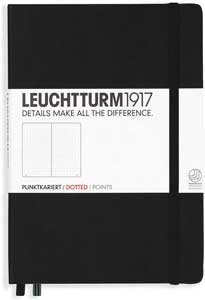 a blank notebook: you can use any notebook, but the most convenient is a notebook with dotted pages (search for “dotted notebook” in English or “carnet pointillé” in French, the most well-known being the Leuchtturm1917);
a blank notebook: you can use any notebook, but the most convenient is a notebook with dotted pages (search for “dotted notebook” in English or “carnet pointillé” in French, the most well-known being the Leuchtturm1917);
- note that you can also use a binder to be able to move the sheets, it’s up to you to decide since the principle is to be able to customize it to the fullest! (even if some purists would say that it’s no longer a real Bullet Journal in this case)
- some questions to ask yourself to choose the format of your notebook:
- what dimensions do you want according to what you want to find on each page: A4, A5?
- do you want spiral binding to be able to open the pages and write in both portrait and landscape mode?
- do you want thick pages to be able to use markers and not see them through the other side?
- what content will you put in it? Do you want to record all areas of your life? You can have several Bullet Journals for different projects too, it’s up to you to see what suits you best,
- a pen, or several pens or markers of different colors and thicknesses if you want to personalize its design, especially with illustrations,
- a ruler to draw lines.
No need to know how to draw, you can make it sober, even ugly and scribbled (even if the fact that it’s pretty makes you want to use it (did you know that we’re physiologically attracted to cute things?)).
Or you can use stickers or even stencils to brighten up your pages.
Some will even create templates and illustrations that you can copy: Instagram, Pinterest, and YouTube are full of ideas and inspiration.
And if you don’t want to draw, you can buy templates, print them out and paste them in. It has become a handmade creation, as they can be found on sites like Etsy, or directly on the online shops of creators:
However, be careful not to put too much pressure on yourself to have a beautiful notebook.
Because the risk is that, being afraid of making mistakes, you may not even dare to use it and write in it.
(And worst-case scenario, there are erasable pens!)
Choosing the notebook comes first because you need one to start, but don’t let it be an obstacle to getting started. You can always change it once you get the hang of it. For my part, I started with a simple spiral notebook with small squares in A5 format.
After finding your notebook, you can create your pages.
Above all, the Bullet Journal is an organizational method, so you can adapt it according to what works best for you, but here is the method created by Ryder Carroll.
Here are the different steps to create your BuJo:
Step 0: Note the page numbers
If you start with a completely blank notebook, you must number each page. You can do it as you create the pages, or all at once at the beginning.
Step 1: Define the symbols to use
On the first page, write down the different symbols you will use throughout the Journal. You can therefore call this page “Keys” like Ryder Carroll, or “Symbols” (whatever works best for you).
The goal being to save time, symbols will allow you to see at a glance the type of actions to be performed. Here are those recommended by Ryder Carroll in his method:
- Classic bullets:
- note
- event (or appointment)
- task to do
- task done
- migrated task
- scheduled task
- cancelled task
- Indicators to put in front of a bullet to differentiate it and highlight it at a glance: important, urgent, inspiration, delegated
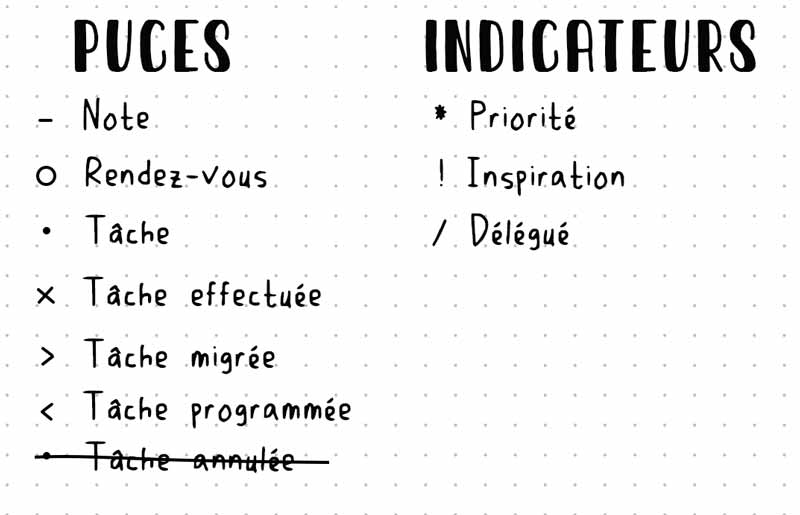
Step 2: Create an Index page
As seen above, this is the table of contents of the notebook: just put the name of the collections and the page number.
Step 3: Create a Future Log page
You can create one or two double pages with the coming months (you don’t necessarily start a Bullet in January, but rather when you create your Bullet for the first time, or when the previous one is finished).
Generally, the dates of each month are written down, in order to see which day falls on each date.
Here’s an example:
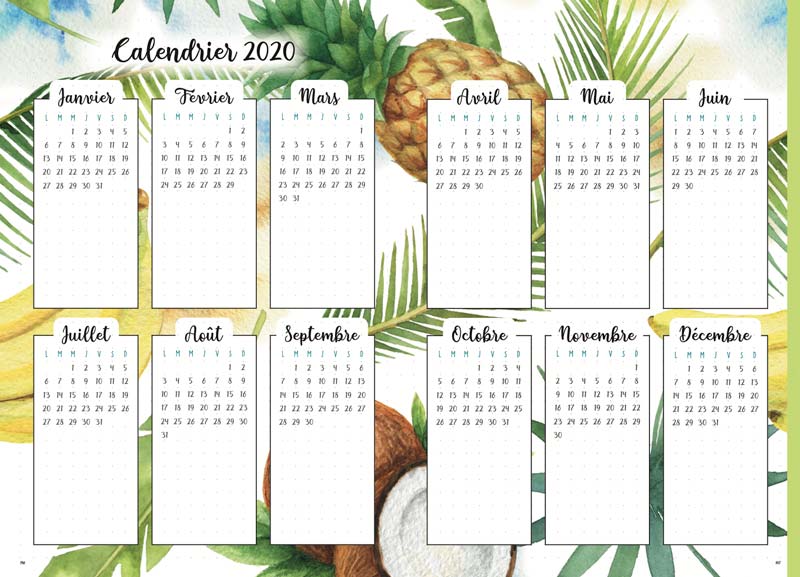
Step 4: Create a Calendex (annual calendar)
This page can be used to get an overview of major events, such as holidays, important birthdays.
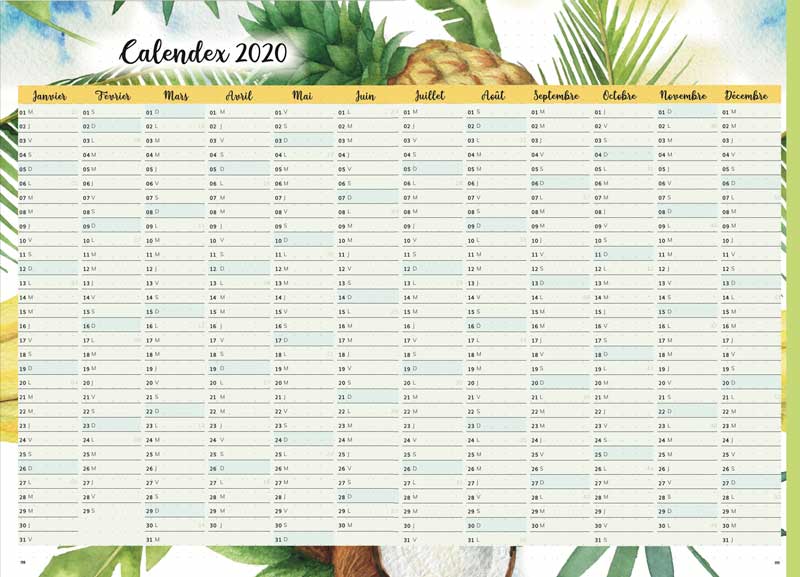
Step 5: Create a Monthly Log page for each month
At the beginning of each month (or rather at the end of the month for the next one), create the Monthly Log.
It’s a page with a line for each date.
This allows you to note appointments for the month, in particular, and important tasks to be done on a specific date.
Step 6: Create a Daily Log page every day
Finally, every day (or the day before is even better), note the date.
Looking at what’s in the Monthly Log, record your appointments and tasks. And possibly add anything you have planned for that day.
Throughout the day, you can also write your notes, as you would in a regular notebook: whether it’s taking notes during a meeting, or your thoughts, your ideas.
That’s why it’s important to not prepare the pages in advance, so you have all the necessary space every day.
If you want to organize by quarter and/or week, you can of course create corresponding pages.
For more details on the method, visit the official Bullet Journal blog.

What can you put in it?
Of course, you can put whatever you want in your BuJo, as you may have already understood. The different calendars you need, as seen earlier:- Annual calendar
- Monthly calendar
- Weekly calendar
- Day planner
- Goals:
- Life goals
- New Year’s resolutions
- Annual goals, annual planning
- Quarterly goals
- Monthly goals
- Weekly goals
- Daily goals
- Professional projects:
- To-do list: classic!
- Ideas
- List of projects, key dates
- Blog:
- Blog post ideas
- Editorial calendar
- Ideas for social media posts
- Ideas for newsletters
- Accounting
- Home management:
- Grocery list
- Cleaning
- Administrative papers
- Family:
- Vaccine dates (not just for children, but also for ourselves)
- Important things not to forget
- Weekly menu, recipe list
- Health:
- Medicines, expiration dates
- Allergies: what to do in case of an allergy
- Sport activities
- Travel:
-
- Countries and cities to visit and already visited
- List of things not to forget, suitcase checklist
- Travel journal
-
- Personal development
- Level 10 Life: our personal rating on 10 areas of our life, the goals to achieve
- Trackers of all kinds: new habits to follow, reading, eating habits, etc.
- Sketchbook
- Dedicated pages for drawing or coloring

What are the benefits of a Bullet Journal?
I have listed for you above the reasons why it is interesting to have a Bullet Journal, but here are other advantages:- You have everything in one place, no need for 10 notebooks that we end up not filling anymore, because it becomes too complicated to manage. We no longer search for where we noted a particular piece of information, because everything is gathered in the same object.
- Writing by hand allows us to concentrate and take a step back, to disconnect from our phone and other distracting elements.
- There is a real community of several million people, with whom we can share and get inspired, or even motivate ourselves to reach our goals, support each other if we have the same issues.
- You find the best organization that suits you, according to your needs: it’s a customized notebook. You become more productive: checking lists becomes addictive!
- It is a perpetual agenda improved: you can start and finish whenever you want, there is no start or end date.
- Get to know yourself better, really improve yourself through personal development: habit lists play a big part, the “10 Level Life” allows us to take stock of all areas of our life and reflect on which points to evolve.

And the disadvantages?
There are, however, some disadvantages to using a Bullet Journal:
- You always need to have your notebook with you, which isn’t always possible (a phone is already cumbersome, especially with the size they are now),
- If you have a large notebook, it can quickly become bulky (and, in fact, no longer desirable to take with you all the time).
- You start with a blank notebook, so you have to recreate the template each time for new pages, unless you make a very, very simple Bullet Journal with just “bullet points”, but in my opinion that would just be a notebook.
- You can waste time illustrating it instead of accomplishing tasks.
- If you’re used to using a notebook that looks more like a scrapbook, you may have trouble filling it in if you’re afraid to make mistakes to keep it looking nice.
- You may take time to find the organization that suits you. But know that there is no perfect Bullet Journal, you can always improve as you go along.
- When you don’t complete a task (or procrastinate), you have to rewrite it the next day: between the Future Log, Monthly Log, etc., you can write the same task or appointment up to 5 times !!! This can also be an advantage: not wanting to rewrite it, so you are more productive?
- It is complicated to first fill out a Future Log, then a Monthly Log, a Weekly Log, and finally the Daily Log. Whereas all you have to do is go to the corresponding date on Google Calendar, for example, when you make an appointment with the eye doctor or dermatologist (i.e. in several months).
- You can thus have duplicates between the paper Bullet Journal and the electronic agenda, or no longer know where you have noted certain information.
For my part, I am a fan of the Bullet Journal concept, but I have always been a proponent of digital tools.
That’s why I created My Bullet online, a digital Bullet Journal, to have the benefits of a Bullet Journal without the drawbacks… and thus have more time for what really matters.
If you haven’t created an account yet, you can do so for free here:
Create a My Bullet online account
In this article, I give you the differences between a traditional Bullet Journal and a digital Bullet Journal.

Your Turn
So, are you convinced to give it a try? Or do you already have your own BuJo?
Tell me in the comments below what you like about using a Bullet Journal.

